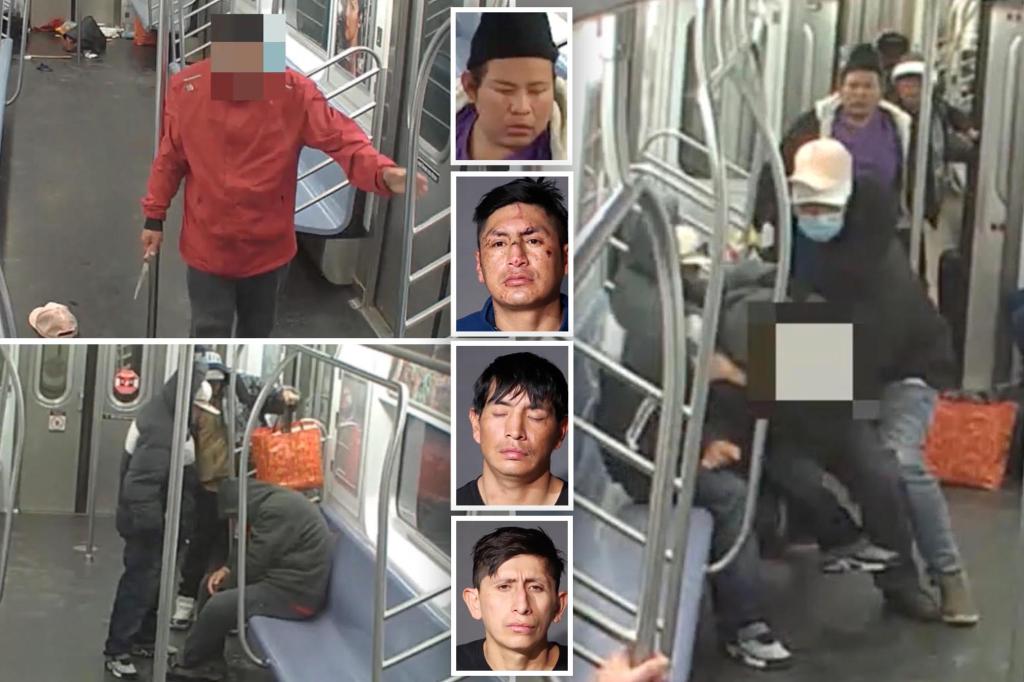This incident aboard a Queens 7 train serves as a stark illustration of the complexities and dangers inherent in urban environments, particularly within public transit systems. The altercation, captured on video, began as a seemingly straightforward robbery but rapidly escalated into a violent confrontation resulting in a fatality. The footage reveals a 69-year-old homeless man sleeping on the train, his belongings targeted by a group of individuals, also identified as homeless. Two of the group, later named as Stalin Moya and Oswaldo Walter, initiated the theft, taking one of the man’s bags into an adjacent subway car. Moya then returned for more of the victim’s possessions, inadvertently rousing the sleeping man. This seemingly minor act triggered a chain reaction of events with profound consequences.
The homeless man, upon realizing his belongings were being stolen, pursued Moya into the next subway car. His attempt to retrieve his property was met not with compliance or even a standoff, but with immediate and brutal aggression from the group. They physically assaulted him, scattering and concealing his bags. The video depicts the victim being shoved and repeatedly punched. This sustained attack pushed him to defend himself, culminating in the deployment of a knife. He lashed out at his attackers, wounding at least two of them. The assailants, surprised by the victim’s counter-attack, scattered, one visibly bleeding from his injuries. The footage shows the victim standing alone in the now-empty subway car, still holding the knife, the adrenaline of the encounter still palpable.
The aftermath of this violent encounter saw a swift response from law enforcement and the Queens District Attorney’s office, aided significantly by the video evidence. Stalin Moya, one of the initial aggressors, did not survive the altercation, while another, Phillipe Pena, sustained injuries. The investigation culminated in the indictment of four individuals – Phillipe Pena, Oswaldo Walter, Jose Valencia, and Henry Toapanta – on robbery and assault charges. The District Attorney, Melinda Katz, made a public statement confirming that her office would not be filing charges against the 69-year-old homeless man for the fatality, emphasizing that the investigation had determined he acted in self-defense while attempting to recover his stolen property. The fact that all individuals involved in this incident were homeless underscores the pervasive challenges faced by this vulnerable population within the city.
The case highlights the importance of surveillance technology in clarifying the sequence of events in such incidents. District Attorney Katz underscored this, stating that the video footage was crucial to the prosecution’s case and reinforcing the importance of cameras in maintaining subway safety for millions of daily commuters. This incident resonates with a broader conversation about safety and vulnerability within public transit systems, raising complex questions about self-defense, the rights of vulnerable populations, and the role of law enforcement in navigating these often challenging circumstances.
The Queens subway stabbing draws parallels with other recent high-profile cases of self-defense and violence within the New York City transit system, which have sparked intense public debate and scrutiny. One such case is the widely publicized incident involving Daniel Penny, a Marine who placed Jordan Neely, a homeless man, in a fatal chokehold on a Manhattan subway train. Penny was subsequently acquitted of manslaughter charges, a verdict that further polarized public opinion on the issue of self-defense and the handling of emotionally disturbed individuals within the public transit system. Another notable case is that of Jordan Williams, who fatally stabbed a homeless man who had allegedly assaulted him and a companion on a Brooklyn subway train. A grand jury declined to indict Williams, effectively clearing him of manslaughter and weapons charges.
These incidents collectively expose a growing sense of unease and vulnerability among transit riders within New York City, fueling anxieties about personal safety and the adequacy of law enforcement responses to crime and disorder within the subway system. The incidents prompt difficult conversations about the appropriate use of force in self-defense situations, the rights and needs of the homeless population, and the responsibility of society to provide safe and accessible public transportation for all. They also raise questions about the effectiveness of existing strategies for addressing crime and disorder within the transit system, the need for improved mental health services, and the challenge of balancing public safety with individual rights and liberties. The ongoing debate underscores the complex interplay of social, economic, and political factors that contribute to the challenges faced by both transit riders and vulnerable populations like the homeless within the urban environment.

